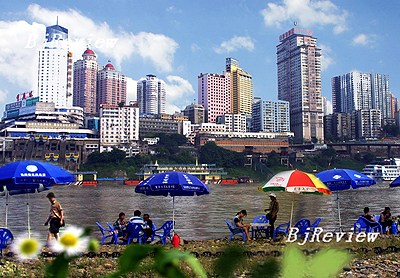| 
Standing at the conjuncture of Yangtze River and Jialing River, surrounded by the foggy beauty of the Three Gorges, the 3,000-year-old city of Chongqing has experienced robust economic growth since it became China's fourth municipality in 1997.
In the last ten years the city has seen an annual average economic growth of 10 percent. At the same time, its fiscal revenue has grown by 10 fold compared to 10 years ago. The development has benefited local residents, whose overall income is now 100 percent higher than it was a decade ago.
In 1997, the Fifth Session of the Eighth National People's Congress (NPC) approved the establishment of the municipality of Chongqing, originally belonging to Sichuan Province.
The establishment of Chongqing Municipality marked the prelude to the nation's development of its western regions, said Xu Jialu, Vice Chairman of the NPC Standing Committee.
The development of Chongqing, accompanied by the construction of the Three Gorges Project, was a key strategy for the country to develop its western regions. The government has hoped the development would alleviate problems stemming from the dense population in Sichuan Province. Residents in the province numbered about 86 million in 1997, ranking third in the country after Henan Province and Shandong Province.
Skyscrapers mushroom
In addition to the fast growing economy, the city's height has witnessed a dramatic rise in the last 10 years. Skyscrapers now dwarf the 27.8-meter People's Liberation Monument, the highest architectural structure in the mountainous city 10 years ago.
The Chongqing World Trade Center, completed in 2005, replaced the monument as the city's tallest building. With 62 floors and more than 260 meters high, the gigantic business building ranks as the tallest in China's western region and is the 46th highest in the world.
"Chongqing has developed so fast in the last 10 years that even local people feel alien to the city," said Li Yuanyuan, a 29-year-old local woman.
The municipality's urban area has expanded from about 300 square km in 1997 to more than 700 square km in 2006.
Skyscrapers and modern residential blocks have mushroomed along avenues, from the city's Yuzhong Peninsula, Chongqing's current Central Business District (CBD), to the municipality's northern farmlands.
"The map of Chongqing needs to be changed every three months," said Wang Hongju, the city's mayor.
Traffic unblocked
Before 1997, Chongqing's expressways were only 114 km long. There was little of today's functioning modern traffic network-only narrow roads connecting the city's urban and suburban areas. It was usually difficult to drive on these roads. Local residents would rather walk than take the buses in some of the city's suburban areas, not mentioning driving.
An anecdote would be good to prove this point. In 1998 when Guo Daorong, the incumbent Office Director of the Chongqing Broadcast, Film and TV Bureau, took a trip to Qianjiang District, a mountainous minority area in the city's southeast, it took him 26 hours to get there from the city proper.
The traffic problems became a major headache for the young municipality. To pave the way for its development, the city has built a strong traffic network in a decade. Its expressways now total 778 km in length, 664 km longer than 10 years ago. Besides, the city paved and improved 5,683-km first- and second-grade roads to solve its traffic problems. It also erected 28 more bridges in addition to the original eight bridges across the Yangtze River and the Jialing River to make the cross-river transportation more convenient.
| 